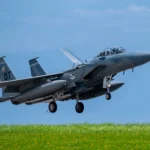On Wednesday, SpaceX is expected to launch the third batch of satellites under the U.S. Space Development Agency’s (SDA) Tranche 1 Transport Layer (T1TL) program. Designated “Transport Layer C,” this mission will deploy 13 small satellites into low-Earth orbit (LEO) as part of a growing military satellite constellation aimed at enabling resilient, low-latency communications and missile tracking capabilities for U.S. and allied forces.
Mission Overview: Transport Layer C Launch Details
The T1TL-C mission is scheduled for liftoff on Wednesday, October 16, from Space Launch Complex 4E at Vandenberg Space Force Base in California. A Falcon 9 rocket will carry the payload into a polar orbit. This marks the third of four planned launches under the SDA’s Tranche 1 deployment strategy.
The launch will place 13 satellites into LEO at an altitude of approximately 1000 km. These spacecraft are part of a broader effort by SDA—a component of the U.S. Space Force—to build a proliferated constellation of hundreds of small satellites that provide tactical data transport and advanced missile warning/tracking capabilities through optical crosslinks and onboard processing.
Tranche 1 Transport Layer: Building a Resilient LEO Backbone
The T1TL initiative comprises four launches—A through D—each deploying approximately a dozen satellites. Once fully deployed by mid-2025, Tranche 1 will consist of up to 126 communication satellites forming a mesh network in LEO. The network is designed to support Joint All-Domain Command and Control (JADC2) by delivering secure, low-latency connectivity between sensors and shooters across domains.
Key features of T1TL include:
- Optical inter-satellite links (OISL): Enabling direct laser-based communication between satellites without ground relay.
- Low latency: Designed for sub-second data delivery across theater-wide distances.
- Resilience: The distributed architecture makes it harder for adversaries to disrupt or disable the entire network.
The T1TL architecture builds on lessons learned from Tranche 0 (launched in April and September 2023), which demonstrated basic functionality with fewer nodes. Unlike legacy geostationary systems with limited agility and higher latency (~600 ms), this LEO-based mesh aims for latency below ~50 ms between nodes—critical for time-sensitive targeting and missile defense operations.
Industry Partners Behind T1TL-C Satellites
The Transport Layer C batch includes spacecraft built by two key contractors:
- Lockheed Martin: Responsible for producing ten satellites under a $187 million contract awarded in August 2020. These are based on Lockheed’s LM400 bus platform with integrated optical terminals developed in partnership with General Atomics Electromagnetic Systems.
- York Space Systems: Delivering three additional spacecraft as part of its broader $94 million contract signed in August 2020. York’s S-Class platform has been optimized for rapid manufacturing and deployment cycles aligned with SDA’s spiral development model.
SDA has emphasized modularity and vendor diversity to avoid single points of failure while encouraging innovation through competition among commercial players. Other vendors involved in different tranches include Northrop Grumman and Blue Canyon Technologies (a Raytheon subsidiary).
SDA’s Proliferated Warfighting Architecture Vision
The T1TL constellation is one layer within SDA’s broader Proliferated Warfighting Architecture (PWA), which encompasses multiple orbital layers serving distinct functions:
- Transport Layer: Low-latency data relay across global theaters via optical links.
- Tracking Layer: Missile warning/tracking using wide-field-of-view infrared sensors optimized against hypersonic glide vehicles and ballistic threats.
- Custody & Navigation Layers (future): Persistent ISR coverage and resilient PNT services independent from GPS vulnerabilities.
Together, these layers aim to provide real-time sensor-to-shooter connectivity across domains—including space-to-ground-to-air—and enhance survivability against anti-satellite threats through distribution and redundancy. The PWA complements existing space assets operated by USSF’s Space Operations Command but introduces faster refresh cycles (~every two years), leveraging commercial production lines rather than bespoke government platforms.
Tactical Implications for Missile Defense & JADC2
The operationalization of T1TL will have significant implications for U.S. missile defense posture and joint force integration:
- Cueing missile interceptors faster: By relaying overhead persistent IR data directly to ground-based interceptors or air defense nodes without relying on terrestrial fiber infrastructure or geostationary relays.
- Tactical edge comms resilience: Providing beyond-line-of-sight connectivity even when terrestrial networks are degraded or jammed—critical in Indo-Pacific or Arctic theaters where infrastructure is sparse or contested.
- Manned-unmanned teaming support: Enabling real-time command links between crewed aircraft or ships and autonomous platforms such as drones or uncrewed surface vessels via space-based relay paths unaffected by terrain masking or EW interference.
Ahead: Tranche D Launch & Spiral Development Model
The final tranche under this phase—T1TL-D—is expected to launch by Q4 FY2025 aboard another Falcon 9 mission out of Cape Canaveral SFS or Vandenberg SFB depending on orbital slotting needs. Meanwhile, planning is underway for Tranche 2 Transport Layer, which will expand capacity while incorporating lessons from earlier tranches including improved cybersecurity hardening, AI-enabled routing algorithms, and enhanced optical terminal interoperability standards such as OISL-STANAGs being developed collaboratively with NATO allies like Germany and Norway under bilateral agreements signed in late FY2023–FY2024.
SDA as Disruptor Within DoD Acquisition Ecosystem
SDA continues to challenge traditional military space acquisition timelines by adhering to its “spiral development” doctrine—fielding useful capability every two years instead of waiting a decade for exquisite systems vulnerable to obsolescence before deployment. With congressional funding support exceeding $4 billion across FY22–FY25 cycles—including over $900 million earmarked specifically for T1TL—the agency has emerged as a key enabler within both JADC2 implementation efforts and broader deterrence posture modernization against near-peer threats such as China’s PLA Strategic Support Force space units or Russia’s GLONASS-integrated EW brigades.










